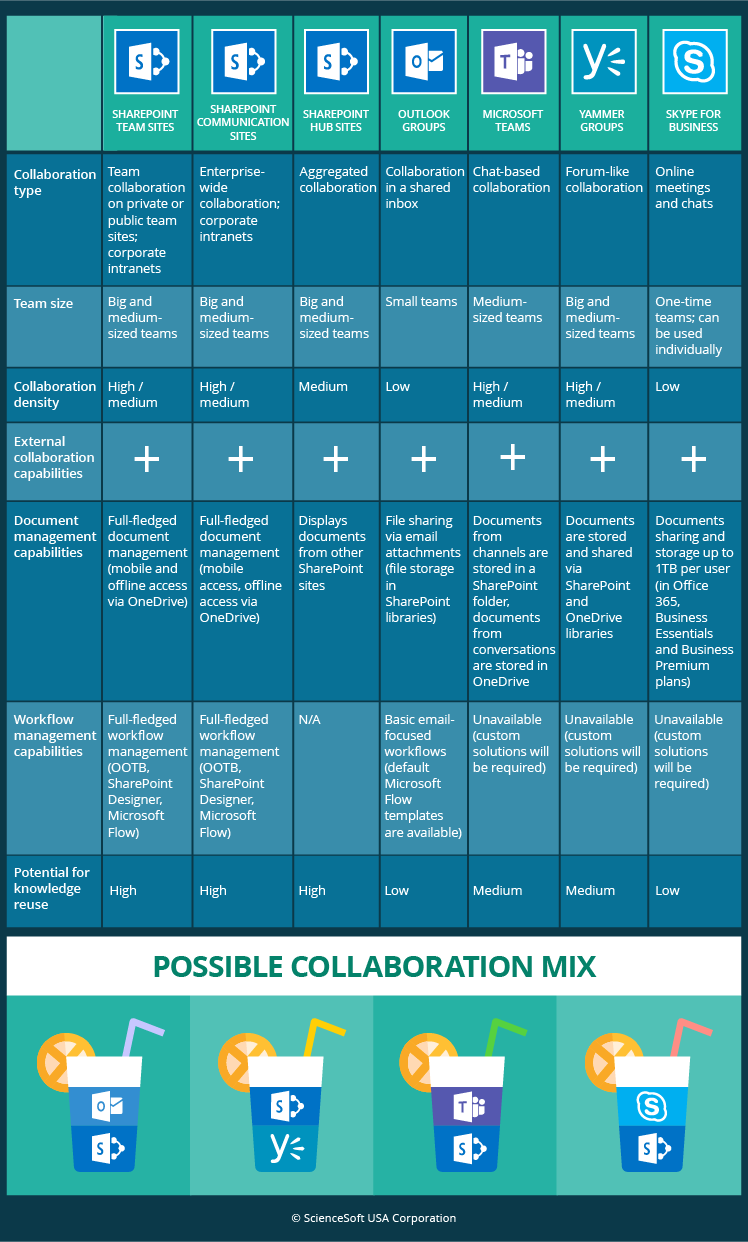Microsoft 365 Collaboration Tools: Comprehensive Overview
While SharePoint On-Premises was Microsoft's key collaboration product, companies were able to build their collaboration strategies relying on its capabilities. The situation changed after the Office 365 (now Microsoft 365) suite was released. Since then, companies' collaboration capabilities start expanding along Microsoft's growing collaboration stack. Unfortunately, the features galore is what can make collaboration the synonym of confusion.
So it's high time to dot the I's and investigate each collaboration option.
What's in the Microsoft 365 collaboration stack?
Microsoft is trying hard to satisfy collaboration needs of teams regardless of their sizes, location, working style and devices in use. This can be the main reason behind such a 'plump? Microsoft 365 collaboration kit that currently includes the following tools:
- Team sites in SharePoint Online
- Communication sites in SharePoint Online
- Hub sites in SharePoint Online
- Outlook Groups
- Yammer Groups
- Microsoft Teams
Lost in multiple collaboration solutions, end-users can hardly understand the difference between them, and companies often hesitate over what collaboration tools to implement and what collaboration scenarios they cover. Let's analyze them one by one.

Team sites in SharePoint Online for familiar team collaboration
We start with SharePoint Online team sites as they inherited the logic of their on-premises predecessors, so they are pretty similar. Using SharePoint Online team sites, users can quickly find a familiar home page with a newsfeed, an activity feed, and document libraries. Thanks to a tight integration of SharePoint Online with OneDrive, teams can keep collaborating on documents from any location and now even without the internet connection via OneDrive Offline Folders.
Powered with Microsoft Flow, SharePoint Online team sites support workflows and enable employees to exchange data with other Microsoft or third-party services. Teams can also use data stored in SharePoint lists to create custom applications enabled with Power Apps. iOS, Android, and Windows 10 Mobile apps support SharePoint on mobile devices, so users can access their team sites' whenever they need.
Recommended collaboration scenario: Team sites in SharePoint Online stay the most powerful collaboration tool in the entire collaboration suite as they foster collaboration of big teams that can communicate, follow team activities, store important resources and links, as well as use workflow and document management features to fulfill their tasks effectively. SharePoint team sites suit various purposes, be it a corporate intranet, a project management system, a learning portal or a knowledge management solution.
Communication sites in SharePoint Online for organization-wide collaboration
Communication sites are to cross team collaboration borders and support company-wide employee interaction. Everything published on a communication site will be automatically available for the entire community on the SharePoint home page, unlike team sites that keep team collaboration private.
Communication sites will also bring a long-awaited simplified customization, which can become a great advantage for users who want to create custom SharePoint sites without involving SharePoint developers. By and large, communication sites aim to give cloud intranets a really corporate nature, thus involving all users into enterprise communication and knowledge sharing.
Optimal collaboration scenario: Communication sites aren't there yet, but already now we can think of the potential collaboration scenarios they cover. Communication sites will work for HR departments, for example, to publish organizational content and make it available for all the employees. This will also be a suitable tool to announce, discuss and promote corporate events, training sessions, spread success stories and best practices.
Hub sites in SharePoint Online for aggregated collaboration
Their major purpose is to put together all the activities of related SharePoint team and communication sites on a single collaboration area. Hub sites will offer the same navigation, search and look-and-feel across all the associated sites, thus making bunches of SharePoint sites well-organized and easy-to-follow.
Optimal collaboration scenario: While SharePoint hub sites won't bring dramatically new features, they are to make enterprise and team collaboration arranged. For example, if a marketing department runs several team and communication sites, they can use hub sites to get all the updates across all sites in one place. This will help team members to stay tuned as well as give a snapshot of marketing activities to top managers.
Outlook Groups for email collaboration
Before diving into Outlook Groups, it's reasonable to mention Microsoft 365 Groups in general. While initially Microsoft 365 had only SharePoint to deal with collaboration, it very soon became clear that robust and feature-rich SharePoint is not always the best tool for lesser collaboration needs. For this very reason, Microsoft expanded Microsoft 365 Groups that now unite all the available collaboration tools and enable employees to sleekly move between them.
Outlook Groups were the first to join the Groups concept and to support collaboration in a shared inbox. Once an Outlook Group is created, users get a set of collaboration tools, including:
- A shared Outlook inbox to support email conversations between group members and external users
- A shared calendar to manage group events
- A SharePoint document library to store and share group files
- A Shared OneNote Notebook to take group notes and ideas
- A SharePoint Team Site to enable full-fledged collaboration capabilities for a group
- A Planner to enable group task management
Recommended collaboration scenario: Outlook Groups can be handy for those employees who prefer email-based collaboration. The tool can also serve those teams well that need to collaborate with external users but don't consider providing them with the access to team sites. Thus, external users will get all the Group's advantages and will be able to collaborate with the team effectively.
Yammer Groups for forum-like collaboration
Microsoft acquired Yammer in 2012. Since then, the previously popular enterprise social network went through multiple ups and downs. Downs were so impressive that the public started to plan Yammer's funerals. Microsoft didn't give up on it, though, which finally brought positive results. While the stand-alone Yammer Enterprise plan was dismissed in January 2017, the tool is now an official member of the Microsoft 365 collaboration family and regains its former popularity.
Yammer Groups' logic is very similar to the one of Outlook Groups. So when a Yammer Group is created, users get access to all the above-mentioned tools (a calendar, Planner, OneNote Notebook, etc.) with the sole exception: shared inbox collaboration transforms into conversation threads in Yammer. The tool also supports file sharing and allows adding external users to the collaboration process.
Recommended collaboration scenario: Although the tool now takes on new roles in an organization (for example, to stimulate knowledge management), its primary purpose is to support forum-like team or enterprise-wide communication. The tool integrated with a SharePoint team or communication site will enable employees to exchange ideas and opinion right on the site's page. If Yammer is the only tool used in the company, teams can still take advantage of SharePoint if, for example, a team using a Yammer Group needs richer document management features.
Microsoft Teams for chat-based teamwork
Provocatively called 'a Slack-killer', the Microsoft Teams tool was released in March 2017. However, by introducing Teams, Microsoft wanted not only to beat their major competitor Slack but also to finally deliver a pure team collaboration tool. Using Teams, employees can create open channels to collaborate on different topics together or organize isolated channels for private communication. Teams also help employees to carry out voice and video conferences. Additionally, Teams can diversify team collaboration with social networking attributes, such as emojis, stickers, and GIFs. Users can also generate custom memes to make the collaboration experience more entertaining or use a variety of bots that can become employees' personal assistants.
Microsoft Teams is integrated with Microsoft 365, which means that team members will be able to benefit from features of other collaboration tools: for example, Teams includes a Files tab that is a SharePoint library to store all the team files. Since September 2017, Microsoft Teams offers a guest access feature to Microsoft 365 commercial and education customers. From now on, external guests can join Teams' activities on equal terms with internal users.
Recommended collaboration scenario: Obviously, Teams should be used for team collaboration. The logic and character of Microsoft Teams will perfectly suit dynamic and enthusiastic teams that aren't restricted by rigid hierarchical boundaries. This is also a nice tool for team members located in different offices or even countries who depend on online meetings or need to constantly collaborate on projects regardless of their location.
Looking at this multitude of collaboration options, companies can think that SharePoint simply got lost among its Microsoft 365 neighbors. However, it isn't true. While various collaboration tools of the Microsoft 365 suite cover different collaboration needs from emailing to video conferencing, SharePoint still stays at the core of team collaboration. And here is why.
- Only SharePoint is able to support content-abundant collaboration. It means SharePoint is the right solution for companies and teams that need feature-rich document management, project management or knowledge management solutions. Fully-functional corporate intranets are impossible without SharePoint either. Teams can collaborate in any of Microsoft 365 Groups, but as soon as the volume of collaboration-related content rises, they will have to switch to SharePoint.
- SharePoint enables workflow-based collaboration. No other collaboration tool can ensure workflows that are essential to successfully manage various business processes. Workflow management can also be critical for those organizations that plan to migrate to the cloud but want to keep the logic of their SharePoint On-Premises solutions.
- Centralized search will be hosted in SharePoint. The diversity of collaboration tools leads us to a logical question: How can users find the relevant information if it is located in different collaboration tools? Well, we have to say that a centralized search capability in Microsoft 365 hasn't been made available yet. Which means users have to look for the information they need across different apps they use. However, Microsoft plans to enable a centralized search across all the Microsoft 365 collaboration tools that will be located exactly in SharePoint.
How to create a perfect collaboration mix?
Various collaboration tools give organizations the opportunity to create their unique team collaboration combo. However, before implementing a particular tool, companies have to first analyze thoroughly the functionality that comes with each particular tool. Then they should detect collaboration patterns inside the organization and those in particular teams.

For example, a small company with 100 employees and 5-10 active teams that need a strong communication medium can opt for Microsoft Teams. At the same time, a mid-sized company with 1,000+ employees and several offices will definitely need a SharePoint-based intranet with strong content management capabilities.
In any case, not to fight alone on this collaboration field, organizations can turn to Microsoft 365 consultants who will help to select the most relevant team collaboration scenario.


